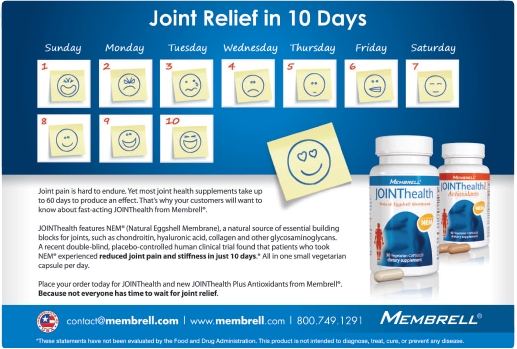Those who are at the mercy of gripping muscle and joint pain are no stranger to discomfort. There is good news: natural therapeutics can help.
Remedies at a Glance
Osteoarthritis (OA), a degenerative joint disease that occurs as cartilage joints wear down, may be helped with capsaicin, a component found in hot peppers that makes them fiery hot (1, 2). Capsaicin works by stimulating and decreasing the intensity of pain signals in the body. Furthermore, capsaicin decreases the amount of “Substance P,” a neurotransmitter believed to discharge inflammation-causing enzymes that set off pain sensations in the brain (1).
the body. Furthermore, capsaicin decreases the amount of “Substance P,” a neurotransmitter believed to discharge inflammation-causing enzymes that set off pain sensations in the brain (1).
Arnica is a common ingredient in topical creams and ointments. It is said to be beneficial for a host of ailments including joint pain, muscle aches and swelling (3). Arnica contains derivatives of thymol, which may have anti-inflammatory effects on the body (4). Arnica is also found as a tincture, and may be used as the base for poultices and compresses (3).
One randomized double-blind study demonstrates arnica’s efficacy (5). During the trial, involving 204 participants with hand OA, the effects of ibuprofen and arnica gel mixtures were compared. Changes in pain relief along with hand function were monitored following 21 days of therapy. Arnica was just as effective as ibuprofen.
Camphor used in topical form is said to reduce itching and relieve discomfort by stimulating nerve endings that relieve pain (6). Camphor also increases local blood flow and is a counterirritant (draws attention away from pain). However, one must not apply camphor to broken skin, as it may enter the body very quickly and be toxic. Such products should be kept out of children’s reach because they may accidentally ingest it.
Many acknowledge menthol for being the m ain active ingredient in peppermint candy. It also is helpful for those with minor aches and pain. Menthol works because it causes one to feel hot/cold, which provides relief from some types of pain (7).
ain active ingredient in peppermint candy. It also is helpful for those with minor aches and pain. Menthol works because it causes one to feel hot/cold, which provides relief from some types of pain (7).
In one trial, participants with OA of the knee and those who experienced severe pain of the elbow and wrist were tested for pain and functional performance before and after (one week) being administered a topical cream; the cream consisted of menthol and cetylated fatty acids, which was applied twice daily (8).
Participants with knee OA showed drastic improvements in stair-climbing performance, range of motion and balance and strength. Those with great pain of the wrist and elbow demonstrated improvements in isometric and dynamic local muscular endurance (8). Evidence suggests that using menthol and cetylated fatty acid reduced pain and improved overall functional performance.
Aloe vera may help those with rheumatoid arthritis (RA). RA is a long-term disease that causes inflammation of the joints and surrounding tissues. Aloe vera offers a soothing, cooling sensation that some with RA prefer to other remedies (10).
Other therapeutics for pain relief include emu oil, MSM (methylsulfonylmethane), omega-3 fatty acids and vitamins A and E (10).
• Emu oil contains omega-3, which has been proven to be particularly useful in easing muscle and joint pain.
• MSM supplies sulfur to the body; a double-blind study showed that patients with OA who used MSM discovered that pain was lessened after six weeks of use.
• Omega-3 fatty acids may be helpful for arthritis pain.
•And, vitamins A and E can thwart OA symptoms, too (10). WF
References
1. Remedy Health Media “Pain Relief for Arthritis With Topical Analgesics,” www.johnshopkinshealthalerts.com/reports/arthritis/128-1.html, accessed Oct. 5, 2011.
2. WebMD, “Capsaicin: Topic Overview,” www.webmd.com/pain-management/tc/capsaicin-topic-overview, accessed Oct. 6, 2011.
3. University of Maryland Medical Center, “Arnica,” www.uamshealth.com/?id=6046&sid=1, accessed Oct. 5, 2011.
4. A. O’Connor, “The Alternative Medicine Cabinet: Arnica for Pain Relief,” http://well.blogs.nytimes.com/2009/09/17/the-alternative-medicine-cabinet-arnica/?hp, accessed Oct. 13, 2011.
5. R. Widrig, et al., “Choosing between NSAID and Arnica for Topical Treatment of Hand Osteoarthritis in a Randomised, Double-Blind Study,” Rheumatol Int. 27(6), 585-91 (2007).
6. WebMD, “Find a Vitamin or Supplement,” www.webmd.com/vitamins-supplements/ingredientmono-709-CAMPHOR.aspx?activeIngredientId=709&activeIngredientName=CAMPHOR, accessed Oct. 5, 2011.
7. Mayo Foundation for Medical Education and Research, Arthritis pain: Creams and Gels for Aching Joints,” www.mayoclinic.com/health/pain-medications/PN00041, accessed Oct. 5, 2011.
8. W.J. Kraemer, et al., “A Cetylated Fatty Acid Topical Cream with Menthol Reduces Pain and Improves Functional Performance in Individuals with Arthritis,” J Strength Cond. Res. 19(2), 475-80 (2005).
9. National Center for Complementary and Alternative Medicine, “Herbs at a Glance,” http://nccam.nih.gov/health/aloevera, accessed Oct. 12, 2011.
10. The Arthritis & Glucosamine Information Center, “14 Ingredients to Ease Joint Discomfort,” www.glucosamine-arthritis.org/arthritis/knockout-arthritis-5.html, accessed Oct. 12, 2011.
Published in WholeFoods Magazine, December 2011









